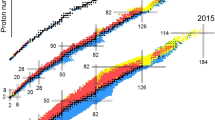Abstract
Isotopic compositions of the strange Xenon components-HL and the s-type xenon can be explained in a straightforward manner as due to the alteration of the isotopic composition of xenon caused by a combined effect of (a) mass-fractionation, (b) spallation and (c) stellar-temperature neutron-capture reactions. As much as 42.49% of total 136Xe (Σ 136Xe) found in the Allende diamond inclusions is 244Pu fission xenon (136fXe) and the trapped xenon is severely mass-fractionated in such a manner that the lighter xenon isotopes are systematically depleted relative to the heavier isotopes. The relative abundances of 130Xe and 132Xe in the trapped xenon component are both markedly enhanced indicating that it was irradiated with a total flux of 1.2·1023 n·cm-2 of stellar-temperature (10 keV) neutrons. The xenon found in the s-type xenon, on the other hand, resemble that of the atmospheric xenon irradiated with a total flux of about 6.0·1023 n·cm-2 of 10 keV neutrons. These results indicate that we are seeing here the effects of nuclear processes occurring inside of a star, such as the exploding supernova.
Similar content being viewed by others
References
E. M. Burbidge, G. R. Burbidge, W. A. Fowler, F. Hoyle, Rev. Mod. Phys., 29 (1957) 547.
J. H. Reynolds, Phys. Rev. Lett., 4 (1960) 8.
P. K. Kuroda, Nature, 187 (1960) 36.
J. H. Reynolds, J. Geophys. Res., 68 (1963) 2939.
A. G. W. Cameron, Icarus, 1 (1962) 13.
J. H. Reynolds, G. Turner, J. Geophys. Res., 69 (1964) 3263.
M. W. Rowe, P. K. Kuroda, J. Geophys. Res., 70 (1965) 709.
J. H. Reynolds, C. M. Hohenberg, R. S. Lewis, P. K. Davis, W. A. Kaiser, Science, 167 (1970) 545.
P. K. Kuroda, Nature Phys. Sci., 230 (1971) 40.
H. Funk, F. Podosek, M. W. Rowe, Geochim. Cosmochim. Acta, 31 (1967).
O. K. Manuel, E. W. Hennecke, D. D. Sabu, Nature Phys. Sci., 240 (1972) 99.
B. Srinivasan, E. Anders, T. B. Draine, Science, 201 (1978) 51.
R. S. Lewis, E. Anders, T. B. Draine, Nature, 339 (1989) 3273.
E. Zinner, M. Tang, E. Anders, Geochim. Cosmochim. Acta, 53 (1989) 3273.
A. O. Nier, Phys. Rev., 79 (1950) 450.
G. R. Huss, R. S. Lewis, Meteoritics, 29 (1994) 791.
R. S. Lewis, S. Amari, E. Anders, Geochim. Cosmochim. Acta, 58 (1994) 471.
P. K. Kuroda, Radiochim. Acta, 62 (1993) 27.
E. Anders, E. Zinner, Meteoritics, 28 (1993) 490.
P. K. Kuroda, W. A. Myers, to be presented at the Symposium on The Origin of Chemical Elements in the Solar System, held in New Orleans, August 22–26, 1999.
Author information
Authors and Affiliations
Rights and permissions
About this article
Cite this article
Kuroda, P.K. Application of Nuclear Chemistry in the Study of the Universe. Journal of Radioanalytical and Nuclear Chemistry 243, 141–145 (2000). https://doi.org/10.1023/A:1006783701207
Issue Date:
DOI: https://doi.org/10.1023/A:1006783701207



